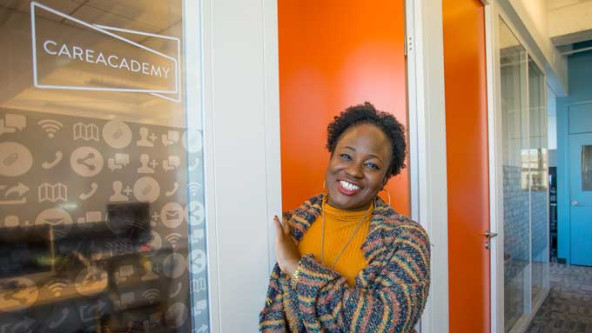 Helen Adeosun is the co-founder and CEO of CareAcademy, which receives funding from Lumina Impact Ventures and produces mobile-based instructional material for home-health aides. (Photo by Shawn Spence Photography)
Helen Adeosun is the co-founder and CEO of CareAcademy, which receives funding from Lumina Impact Ventures and produces mobile-based instructional material for home-health aides. (Photo by Shawn Spence Photography)
To borrow a frequently used legal phrase, the low educational attainment of minorities in the United States should shock the conscience of America. The most recent Census figures show that 47 percent of white Americans hold at least an associate degree. Degree attainment rates are far lower among other groups: Only 31 percent for African-Americans, 25 percent for American Indians, and 24 percent among Latinos.
None of these numbers is good, particularly in a country that ranks among the wealthiest, and that aspires to world leadership in fairness and opportunity. They also fail to capture the stakes for educational have-nots. We know that college degrees, industry certificates, and other high-quality credentials create economic opportunity and increase social mobility. Two-thirds of new jobs require credentials beyond the high school diploma, and without such credentials, millions of people face a steady decline in their standard of living.

These barriers to opportunity will affect all Americans eventually, as companies and managers continue to endure a workforce shortage numbering in the millions—a shortage that limits the country’s ability to compete in the global economy.
Lumina Foundation is working at this intersection of fairness, education, and opportunity. As the nation’s largest foundation devoted exclusively to higher education, our goal is to help policymakers, institutions, businesses, and others grow the national attainment rate of degrees and other post high-school credentials from 48 percent to 60 percent by 2025. To achieve this level of change, however, all of us who support equity in education need to not only make improving equity and attainment part of our stated goals, but also match our social justice message with a shared economic narrative.
Investing in Racial Equity
Over the past decade, our foundation has invested in racial equity through both grants and impact investing. In response to the racially motivated violence in Charlottesville, Virginia, in 2016, for example, we created the Fund for Racial Justice and Equity. The fund has so far provided 19 grants to colleges and universities working to foster constructive racial dialogue on their campuses. And in 2017, we created the Talent, Innovation and Equity Partnership program. This effort provides grants, research, and other supports to help a select group of states increase college completion. One goal is for these states to provide leadership in this area, particularly in closing gaps in educational attainment linked to race, ethnicity, and income status.
In 2010, we carved out 2 percent of our endowment to invest in fund managers who had expertise in building portfolios of companies that align with Lumina’s mission and deliver market-rate financial returns. We’ve since brought that expertise in house with the creation of Lumina Impact Ventures (LIV). The purpose of LIV is to make direct investments in individual companies that are aligned with our mission and can help accelerate our progress.
An important function of LIV is to identify and invest in entrepreneurs whose ideas can reach and serve a wide array of people. Rather than solve a highly specialized problem, we aim to serve more people better—to make high-quality education and training more widely available, especially among populations that have historically been underserved.
Companies in the LIV portfolio include Credly, the largest platform for competency-based digital credentials; Cell-Ed, which helps low-income workers acquire literacy, language, and job skills through their mobile devices; and CareAcademy, which develops online training for health care aides. CareAcademy serves many first-generation people with a history of low-wage work, offering training that can lead to certification as well as collegiate learning. Over half of our portfolio companies were either founded by or are currently led by a person of color.
Leveraging Ideas and Capital, and Pursuing Social Outcomes
These kinds of direct equity investments are unusual for a large foundation and come with certain challenges. If we use grant dollars, we structure them as program-related investments (PRIs)—investments aligned with our mission and aimed at achieving the social outcomes we’re pursuing. Also, we must legally demonstrate that our primary objective in investing is to advance our cause, not to make money. These investments are powerful tools that allow us to leverage ideas and capital by supporting entrepreneurs who are developing innovative, scalable solutions to social issues.
Unlike standard investors, Lumina represents more than just a source of capital. Our reputation as a leader in higher education and, more recently, in impact investing can help validate the quality and potential of the products, technologies, and services we support, and thus attract other investors. And because our investments support market validation, they help companies advance to subsequent rounds of investment that can provide growth capital to achieve even greater impact.
As with all investments, returns are uncertain. Although we naturally would like to see some financial return, we’re most interested in whether any given company can achieve the social outcome it’s pursuing. If so, we are comfortable taking on a higher level of risk that other investors might avoid.
There’s ample reason for us to be bold about this. In fact, as a private foundation, it’s our job to take risks where others simply can’t—to serve the public good. Unlike the government, we can’t be voted out of office if we’re not immediately successful. And we’re not a publicly traded company whose shareholders might revolt.
Measuring Outcomes
Traditionally, foundations have made PRIs in partnership with community-based entities and through low- or no-interest loans, often in housing. But this new model of direct investment by a philanthropy is gathering interest, including among my fellow members of the President's Council on Impact Investing at the US Impact Investing Alliance.
Yet as different and intriguing as the approach is for our foundation, it’s more than just a shiny new tool. We want everything we do—in grantmaking, public policy, convenings, and communications—to work toward our goal, and so we’ll measure these investments by the same standards we measure our other tools.
We expect to see some failures; that’s the nature of early-stage companies, after all. It may be that we invest in 10 companies, and only two or three survive. We’ll judge the results as they happen, but if none of these firms fails, well, perhaps we have—by being too risk-averse.
Lessons from Others
Our definition of success also must include the non-financial benefits from a direct-investment portfolio, especially the “learning return” and how that accelerates Lumina’s other efforts. We can draw lessons from the entrepreneurs we invest in, and we can benefit from their networks and solutions to inform our grant-funded work. For example, Credly has partnered with the American Council on Education, a major Lumina grantee, to launch a new digital credential program that recognizes workforce training.
Given recent market swings, we’re also considering what happens in the event of an economic downturn. Many experts expect a recession in the next few years, and we don't know how that will affect the market and entrepreneurial spirit. But we’ve accepted that uncertainty as part of investing. We learn everything we can, try what should work, and learn from the results, good and bad.
If that also sounds like the path of social progress, it should, because both investing and societal improvement require patience and an understanding of the fundamentals. And in both, rewards entail some risk. Happily, we’re already seeing benefits from the innovations of our partners. And while we have much more to learn, the greater challenge to progress would be to stay out of the marketplace of ideas and innovation.
Support SSIR’s coverage of cross-sector solutions to global challenges.
Help us further the reach of innovative ideas. Donate today.
Read more stories by Jamie Merisotis.

